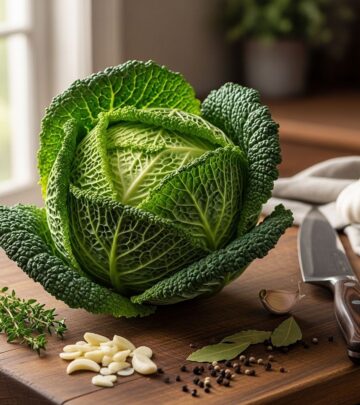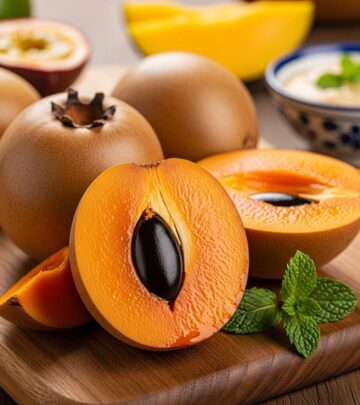Tangerines: Nutrition, Varieties, Benefits, Uses, and Recipes
A sweet, tangy snack that nourishes skin, eases digestion, and uplifts daily vitality.

Tangerines: An Overview
Tangerines (Citrus reticulata) are small, orange-colored citrus fruits renowned for their sweet-tart flavor and easy-to-peel skin. Named after the port of Tangier in Morocco, tangerines belong to the mandarin family and are often confused with similar fruits like clementines and satsumas. Packed with vitamin C, antioxidants, and dietary fiber, tangerines have become a staple in diets across the world, both for their taste and nutritional value.
Varieties Of Tangerine Fruit
Tangerines come in a range of varieties and hybrids, each with unique taste profiles, sizes, and physical characteristics. Understanding these types helps in choosing the best fruit for culinary or snacking purposes.
- Dancy: Known as the “Christmas tangerine,” this variety ripens in December. Dancy tangerines feature a red-orange skin, leathery texture, tart flavor, and are easy to peel.
- Sunburst: Among the most widely commercially grown, Sunburst tangerines are harvested in November. They have a dark-orange color and a mildly acidic, sweet taste.
- Clementines: Small, seedless hybrids between mandarins and sweet oranges, clementines offer sweet, juicy flesh and a smooth, glossy peel. Their easy-peel nature makes them a popular snack choice.
- Tangelos (Honeybells): These hybrids of tangerine and grapefruit have loose skin and juicy, sweet arils. A distinctive knob at the stem end sets them apart from other varieties.
- Tangors (Citrus nobilis): Large hybrids combining tangerines and sweet oranges. Tangors boast a sweet-tart flavor, reminiscent of oranges with the easy-peeling property of tangerines.
- Yuzu (Japanese citrus): Resulting from a cross between papeda and mandarin oranges, yuzu fruits are tart with an intense lime-like fragrance, often favored for culinary uses in East Asia.
- Other Hybrids: Markets promote hybrids like Murcotts, Minneolas, and Satsumas. Many are branded for specific taste and seed profiles.
Nutritional Profile Of Tangerines
Tangerines are not only delicious but incredibly rich in nutrients crucial for health. Slightly less acidic and containing more sugar than oranges, tangerines are an excellent choice for those seeking a sweet, juicy fruit option.
| Nutrient (per 100g) | Amount |
|---|---|
| Energy | 53 kcal |
| Carbohydrates | 13.3 g |
| Protein | 0.8 g |
| Fat | 0.3 g |
| Fiber | 1.8 g |
| Vitamin C | 26.7 mg |
| Vitamin A | 681 IU |
| Potassium | 166 mg |
| Calcium | 37 mg |
Tangerines are a significant source of vitamin C, essential for immune health, and fiber, which supports digestive function. Their low-calorie content and lack of cholesterol make them a healthy addition to most diets.
Health Benefits Of Tangerines
Tangerines’ impressive nutrient content translates into multiple health benefits:
- Boosts Immunity: High vitamin C content enhances the body’s natural defense against infections and illness.
- Antioxidant Properties: Rich in compounds such as beta-carotene, flavonoids, and vitamin C, tangerines help protect cells from oxidative stress, reducing cancer risk.
- Supports Heart Health: Potassium and fiber in tangerines contribute to a healthy heart by lowering blood pressure and managing cholesterol levels.
- Weight Management: Low calorie and high fiber content promote satiety without adding excessive calories, aiding weight loss efforts.
- Promotes Skin Health: Antioxidants and vitamin C support collagen production, helping skin retain elasticity and heal faster.
- Improves Digestive Health: Dietary fiber aids regular bowel movements and supports a healthy gut flora.
- Supports Eye Health: Tangerines contain vitamin A and beta-carotene, both crucial for eye health and vision protection.
How To Select And Store Tangerines
For peak freshness and flavor, follow these tips when selecting and storing tangerines:
- Choose fruits that feel heavy for their size and have a soft yield when gently squeezed, indicating juiciness.
- Look for skins ranging from bright orange to red-orange; dull skin may indicate overripeness or poor quality.
- The peel should be loose and easy to remove, with a fragrant aroma present.
- Store tangerines at room temperature if consuming within a few days; otherwise, refrigerate to prolong shelf life.
- Avoid fruits with soft spots, mold, or excessive blemishes.
Culinary Uses Of Tangerines
Tangerines are exceptionally versatile in the kitchen. Their balance of sweetness and acidity pairs well with a wide array of foods and recipes:
- Standalone Snack: Enjoy fresh segments as a convenient, healthy snack any time.
- Dessert Pairings: Combine with cottage cheese, yogurt, or ricotta for a nutritious dessert.
- Salads: Add peeled and segmented tangerines to green salads for a refreshing citrus twist.
- Glazes and Sauces: Use tangerine juice or segments in glazes for poultry and seafood, or as a sauce base for vegetable dishes.
- Drinks and Smoothies: Blend tangerine juice with other fruits for vitamin-packed smoothies or creative cocktails.
- Main Courses: Incorporate tangerines in stir-frys, rice dishes, or couscous recipes for a sweet, complex flavor.
Tangerine Recipes
Below are two simple, delicious recipes that showcase tangerines’ versatility:
1. Choco-dipped Tangerines
- Ingredients:
- 1 tangerine, peeled and segmented
- 10g dark chocolate, melted
- Instructions:
- Dip each tangerine segment halfway into the melted chocolate.
- Place segments on a parchment-lined baking tray.
- Refrigerate for an hour or overnight until set.
2. Tangerine Martini
- Ingredients:
- Ice
- 3 oz freshly squeezed tangerine juice
- 1.5 oz vodka
- 1 tsp orange-flavored liqueur (e.g., Cointreau)
- Instructions:
- Combine ice, tangerine juice, vodka, and orange liqueur in a martini shaker.
- Shake vigorously until chilled.
- Strain and pour into a martini glass; serve immediately.
Frequently Asked Questions (FAQs)
Q: Are tangerines and clementines the same?
A: While both are from the mandarin family, tangerines and clementines differ slightly in size, sweetness, and skin texture. Clementines are typically smaller, seedless, and have a smoother peel, whereas tangerines may contain seeds and are a bit larger with rougher skin.
Q: What is the best season for tangerines?
A: Tangerines are predominantly available in late fall through winter, with some varieties harvested as early as November and others peaking in December or later.
Q: How are tangerines good for the skin?
A: Tangerines are rich in antioxidants and vitamin C, which help promote collagen synthesis, fighting signs of aging and protecting against environmental damage.
Q: Can tangerines help with weight loss?
A: Yes, their high fiber and low-calorie content make them excellent for weight management, providing satiety without excess calories.
Q: Are tangerines safe for diabetics?
A: Generally, tangerines can be enjoyed in moderation as part of a balanced diabetic diet. Their natural sugars are balanced by fiber, helping regulate blood sugar spikes.
Interesting Facts About Tangerines
- Tangerines originated from Southeast Asia and have been cultivated since ancient times.
- The name “tangerine” comes from Tangier, Morocco, once a major port for the fruit’s export.
- Unlike oranges, tangerines have a thinner, more loosely attached peel, making them easier to eat on the go.
- In commercial markets, tangerines are often branded under their specific variety names for consumer appeal.
Potential Side Effects
- Excessive consumption may cause digestive discomfort due to natural sugars and acids.
- People with citrus allergies should avoid tangerines.
- Overconsumption of vitamin C-rich fruits may contribute to kidney stone development in susceptible individuals.
Conclusion
Tangerines serve as a delicious, healthy, and versatile fruit, offering numerous vitamins and minerals while fitting into a variety of recipes. Whether consumed alone or added to elaborate dishes, tangerines bring vibrant flavor and notable health benefits to your diet. Their seasonal availability and diversity in varieties make them a popular choice for wellness-focused culinary adventures.
References
- https://www.masterclass.com/articles/tangerine-fruit
- https://www.stylecraze.com/articles/tangerine/
- https://specialtyproduce.com/produce/Tangerines_12316.php
- https://www.autostraddle.com/a-trans-woman-of-color-responds-to-the-trauma-of-tangerine-301607/
- https://www.stylecraze.com/articles/benefits-of-mandarin-oranges-for-skin-hair-and-health/
- https://perfumesociety.org/ingredients-post/tangerine/
Read full bio of Sneha Tete












